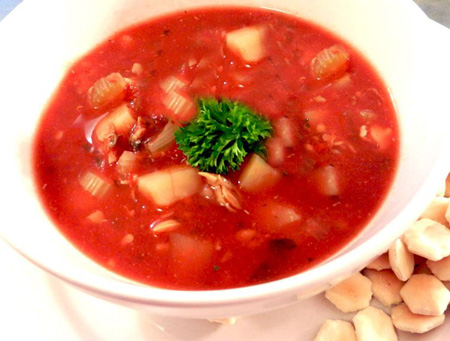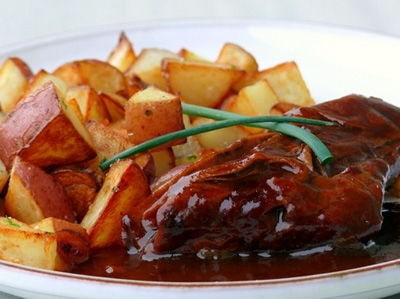 Although New England Clam Chowder (the white creamy version) is probably more popular, Manhattan Clam chowder is equally delicious. More like an Italian soup, this tomato based clam chowder makes a great winter dish.
Although New England Clam Chowder (the white creamy version) is probably more popular, Manhattan Clam chowder is equally delicious. More like an Italian soup, this tomato based clam chowder makes a great winter dish.
Traditional recipes often require cooking fresh clams and using the cooking broth in the chowder (which is fine if you have the time) but I find that using canned clams and bottled clam juice makes this recipe more manageable, without sacrificing taste or quality.
Bal Harbor clam juice is available in most grocery stores and has great flavor. It’s made from steaming whole, premium clams and is triple-filtered. This soup will keep refrigerated for up to 2 days, and the flavors continue to meld. Reheat over a low heat, and make sure not to boil the chowder, which can toughen the clams.

 Another workhorse of a vegetable, Butternut Squash is always on my shopping list and in my inventory during the fall and winter months.
Another workhorse of a vegetable, Butternut Squash is always on my shopping list and in my inventory during the fall and winter months. Kale is in season right now with the common curly kind leading the pack. But there's also a darker, more unique variety that hails from Italy. Tuscan kale is darker in color, more delicate in flavor, and tender to eat. It's especially great in salads and it holds up to many bold flavors. If you're craving a salad this winter, Tuscan kale should be your green of choice.
Kale is in season right now with the common curly kind leading the pack. But there's also a darker, more unique variety that hails from Italy. Tuscan kale is darker in color, more delicate in flavor, and tender to eat. It's especially great in salads and it holds up to many bold flavors. If you're craving a salad this winter, Tuscan kale should be your green of choice. Sweet potatoes are having their moment—at least according to my favorite New York Times reporter, Kim Severson. It seems their new fame is largely due to the popularity of sweet potato fries.
Sweet potatoes are having their moment—at least according to my favorite New York Times reporter, Kim Severson. It seems their new fame is largely due to the popularity of sweet potato fries. Brisket....I'm licking my lips. I love it. I've always loved it...as long as it's cooked right. Let's face it, it's a tough, flat piece of meat. It's a chest muscle. The only way to cook it right, is low and slow...which is why we braise. And the Guinness adds a nice layer of deep complexity to the sauce, just like red wine does to a pot roast. However, since the barley used to make Guinness is roasted, you get this really deep flavor in dished like this.
Brisket....I'm licking my lips. I love it. I've always loved it...as long as it's cooked right. Let's face it, it's a tough, flat piece of meat. It's a chest muscle. The only way to cook it right, is low and slow...which is why we braise. And the Guinness adds a nice layer of deep complexity to the sauce, just like red wine does to a pot roast. However, since the barley used to make Guinness is roasted, you get this really deep flavor in dished like this.
